According to our Content Marketing Survey, 70% of marketers measure their content performance by traffic, 38% on social shares, and 31% on backlinks. Therefore, it would definitely be interesting to find out which content characteristics can help increase pageviews and make a blog post more shareable and linked to.
Of course, the copy’s performance is ruled first and foremost by its originality and relevance, but factors such as word count, headlines, structure, and visuals are sure to play their role.
Using our data — and guided by marketing curiosity — we analyzed the visits, backlinks, and social shares of 1,200,000+ articles we picked from domains with a blog section that had from 30,000 up to 500,000 sessions. We tried to establish the correlation between metrics and different text elements and characteristics. Specifically, these were:
-
Length (i.e. word count)
-
Headlines (including headline types and H1 length)
-
Structure (including heading depth and list presence)
-
Visual Content (including image and video presence)
We are excited to present the results of this study below and hope that it will help you improve your own blog.
The present research was conducted as a part of the Global State of Content Marketing Report 2020. The report is designed to let content marketers explore the best industry practices and empower their marketing strategies.
Key Findings of the Research
-
Longreads (7,000+ word articles) are absolute leaders in terms of content performance, as they drive almost 4 times more traffic than articles of average length (900-1,200 words).
-
More than half of the posts with a complex structure (h2+h3+h4) are high-performing in terms of traffic and engagement. 44% of posts with a simple structure (h2+h3) are also high-performing. 39% of texts with no structure at all (no h2) are low-performing in terms of traffic and engagement.
-
Posts containing at least one list per every 500 words of plain text get 70% more traffic than posts without lists.
-
10 to 13-word headlines drive twice as much traffic and X1.5 more shares than shorter ones (< 7 words).
-
Posts with at least one image get twice as much traffic as posts containing text only. These also get 30% more shares and 25% more backlinks.

Content Length
A 2019 study from researchers at the Technical University of Denmark suggests that, due to the amount of information presented to the public, our collective global attention span is narrowing. However, at the same time, the average post length increased by around 42% between 2014 and 2018, from 800 words to 1,151 words.
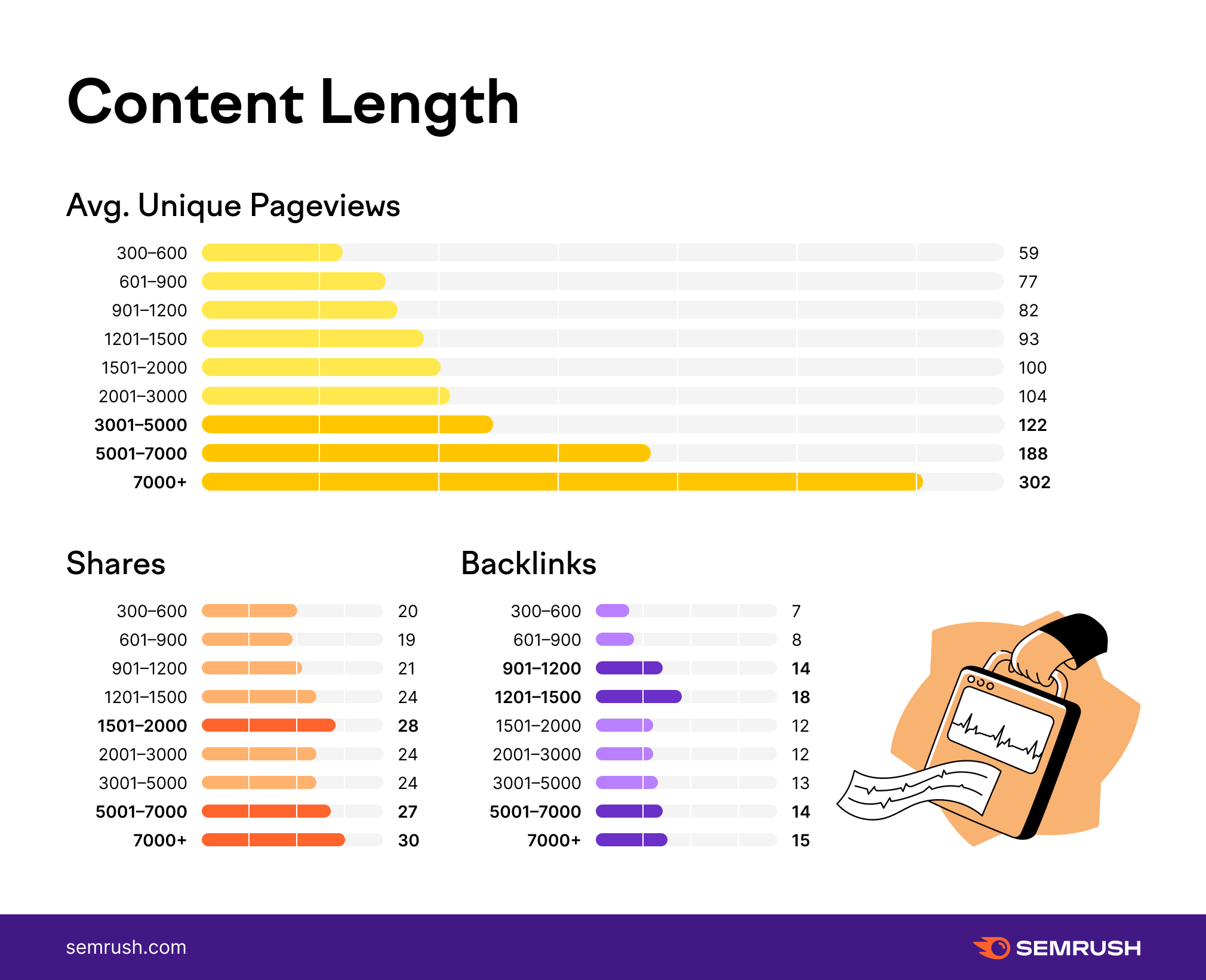
Key Takeaway: 7,000+ word articles drive almost 4 times more traffic and 43% more shares than articles of average length (900-1,200 words). Meanwhile, short posts (300-900 words) gain 21% less traffic and 75% less backlinks than articles of average length (900-1,200 words).
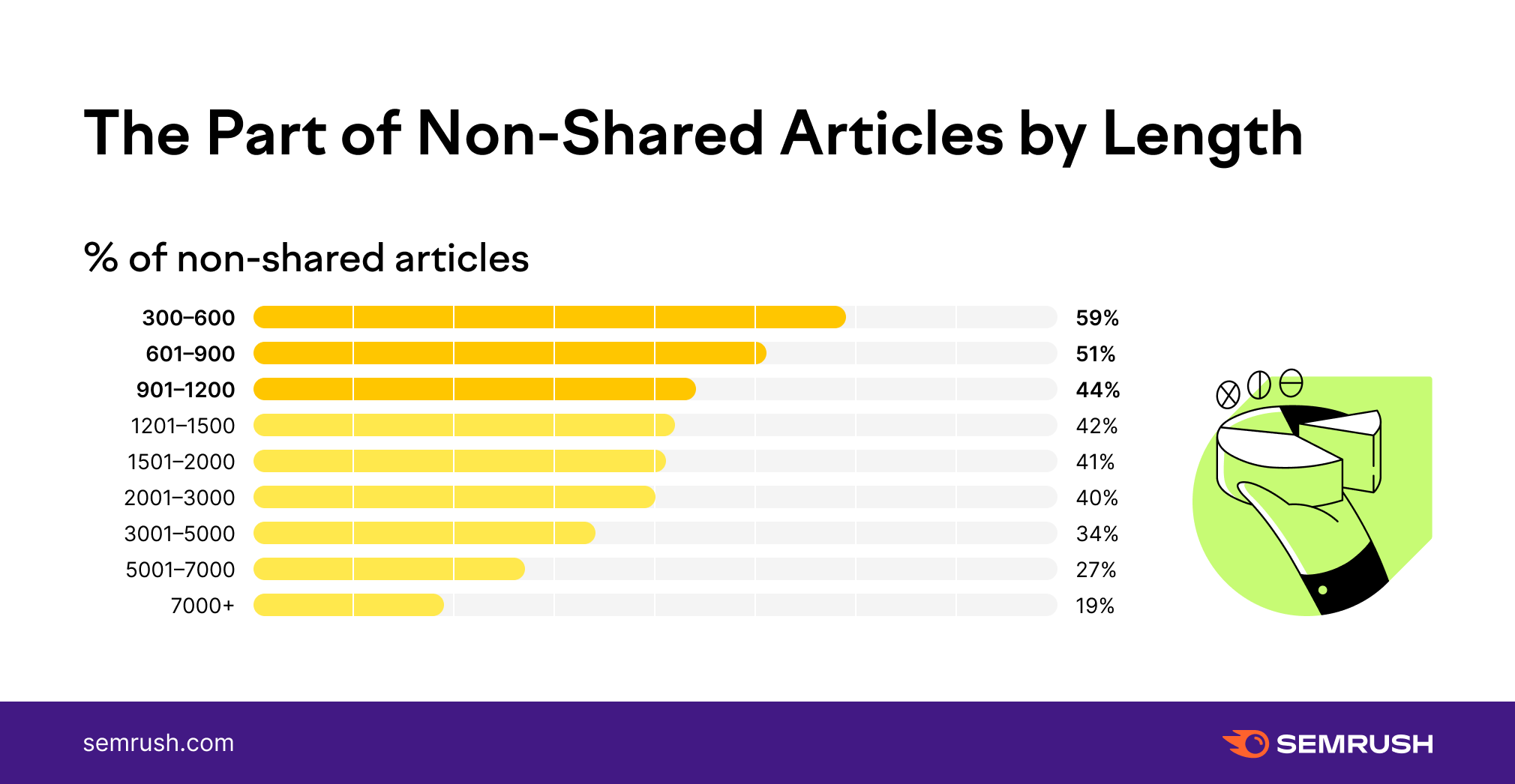
Key Takeaway: Less than half of articles between 300 and 900 words are shared, while over 80% of 7,000+ word articles are shared.
Although long-form content is clearly the “winner” here, it’s important to understand that simply writing longer articles is not a guarantee of success — nor will it automatically bring you more traffic.
Indeed, longreads likely perform better because they provide users with in-depth information on the topic — not just because they contain more words. When creating your copy, you should bear this in mind. Focus on the core elements of successful content — such as unique and engaging text, strong research, and relevant information — rather than simply how long it is.
This ties into what your users are looking for, too. If your audience only wants a short answer to a particular question, then a 20-minute bulk read is only going to turn them off. In cases like this, a shorter article may be more beneficial, so ensure you analyze user intent and understand your audience’s needs before you begin writing.
Semrush’s SEO Writing Assistant can help you with this, enabling you to identify the ideal content length based on competitors’ articles that rank for your target keywords.
Headlines
The headline is one of the most important elements of an article, acting as a window to the content. The reader uses this headline when deciding whether to open the article or not.
There are a number of different approaches that you can adopt — but which ones tend to perform well?
Types of Headlines
There are a variety of ways to find the right headline for a blog post: you can pick a popular question asked on the net, or offer a guide that solves a specific problem.
During our research we tried to figure out which headlines help you get the most pageviews, backlinks, and shares.

Key Takeaway: Lists get 80% more traffic than other types of articles.
The interest in listicles is based on the three key features that, according to The New Yorker, make them so captivating for our brains:
-
Such headlines stand out in a stream of content as they usually contain numbers.
-
The subject is placed within a category or classification system.
-
The information looks trustworthy and well organized.
Together, these factors cater to our data-hungry minds in a way that is reliable and easy to digest.
Listicles are closely followed by guides and how-to articles, driving 38% more traffic compared to other types of articles. These kinds of headlines offer readers the opportunity to learn something and demonstrate that the solution to their problem may be just a click away.
If you want to see which kind of content format is the most effective for your goals, you can use the ImpactHero tool. It allows you to compare the performance of your content by type and length, using seven performance metrics.

H1 Length
Aside from being catchy, your headline is supposed to let your audience quickly understand the essence of your copy. In theory, it’s the same for search engines, too. The only problem is that space is at a premium, so you need to come up with an enticing hook.
To get a better understanding of what the ideal H1 length might be, we consulted the data to identify the key patterns and trends.
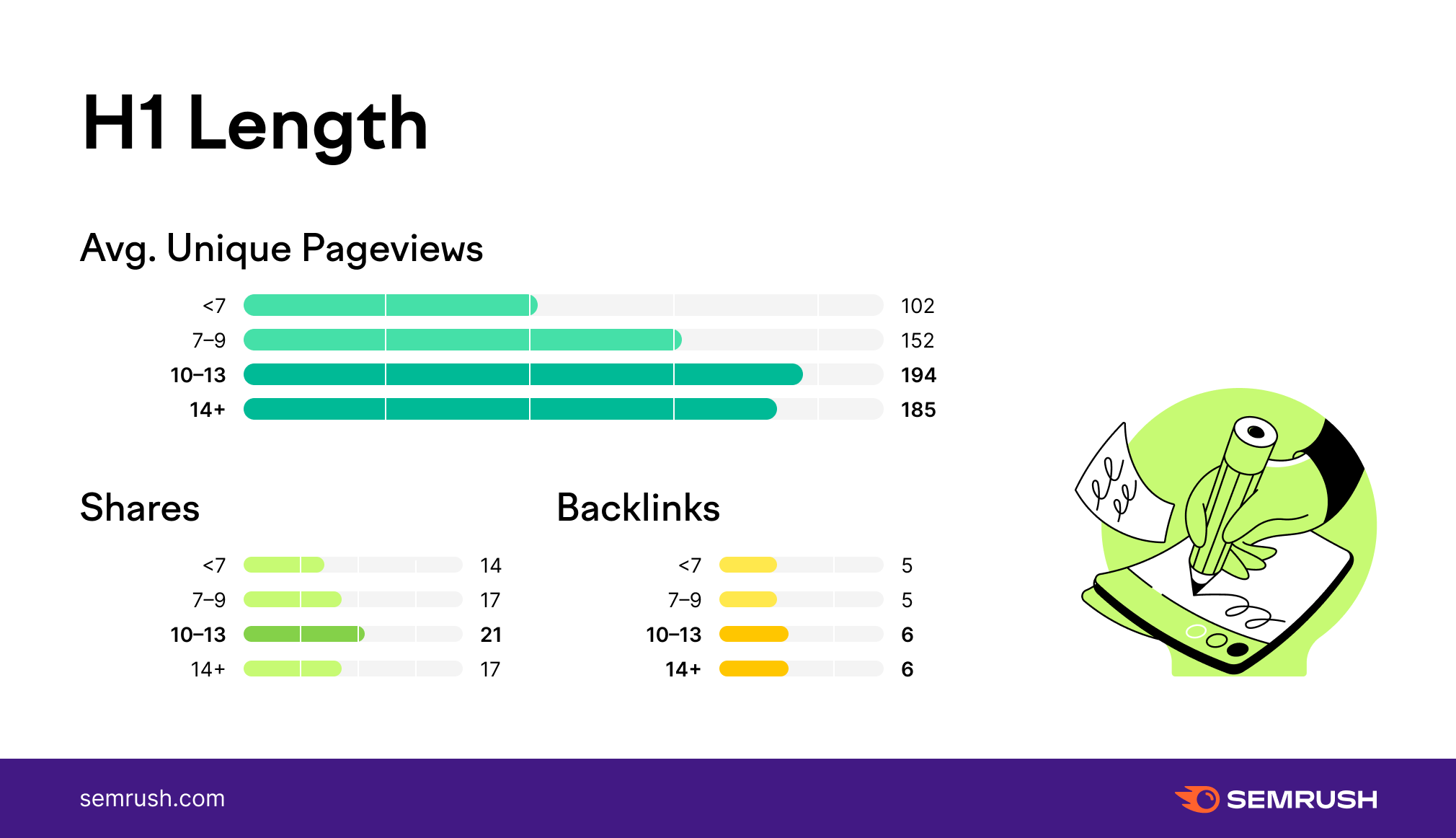
Key Takeaway: 10 to 13-word headlines drive twice as much traffic and X1.5 more shares than shorter ones (< 7 words).
Longer headlines can provide more information on what the copy is about. This is important, as if there is no relation between the title and the content, Google may disregard the content as low quality. This likely explains why H1 titles of over 10 words perform better (although this is not necessarily the case for all audiences and types of content).
It’s not just about length, though. When creating your H1 title, make sure you still focus on the core elements of what makes a good headline, such as:
-
Making it unique and comprehensive.
-
Using numbers or question words.
-
Describing what is discussed in the text body.
-
Ensuring it stands out on the page.
-
Addressing user intent.
In terms of shares, a 2019 study by Backlinko reveals a similar trend. Longer titles get more social shares, with very long headlines (14-17 words) getting 76.7% more shares than short titles.
Structure
After the headings we analyzed the structure of the copy — namely its heading depth (the presence of H2, H3, and H4 tags), and the presence of lists. This information can give you some ideas on how to lay out your text to potentially increase engagement and traffic.
Analyzing Heading Depths
First, we looked at the presence of H2, H3, and H4 tags in the articles from our dataset:
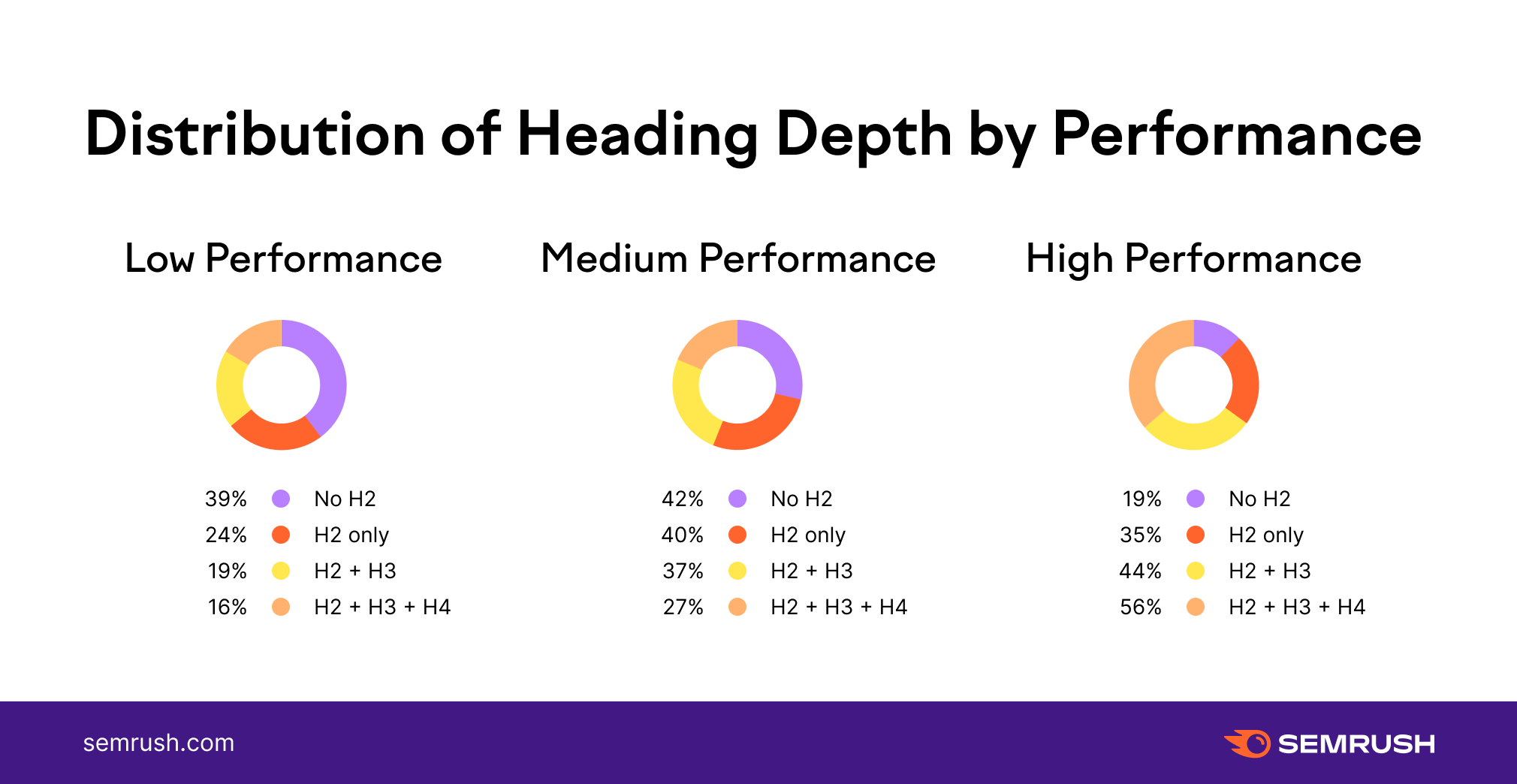
Key Takeaway: More than half of the posts with a complex structure (H2+H3+H4) are high-performing.
From the data above we can see that a three-level text structure (H2, H3, and H4) is enough to break down any article (even longer ones) into meaningful pieces, and improve its readability and visual appeal.
In fact, this approach is recommended by Google itself, which advises against condensing large blocks of text onto a page “without paragraph, subheading, or layout separation.” John Mueller expanded on this in December 2019, stating that heading tags help Google to better understand what the text is about, and to better frame it as a potential solution to user search queries.
Therefore, it’s crucial to ensure that your content is structured properly. The correct use of H2, H3, and H4 tags enables you to segment your content into logical, digestible sections, divert attention to relevant user questions, and highlight the most important ideas in your text.
The Use of Lists
The next characteristic we looked at is the presence of lists (<ul> and <ol> tags), their distribution in a piece of content, and the prevailing trends and patterns that emerge.
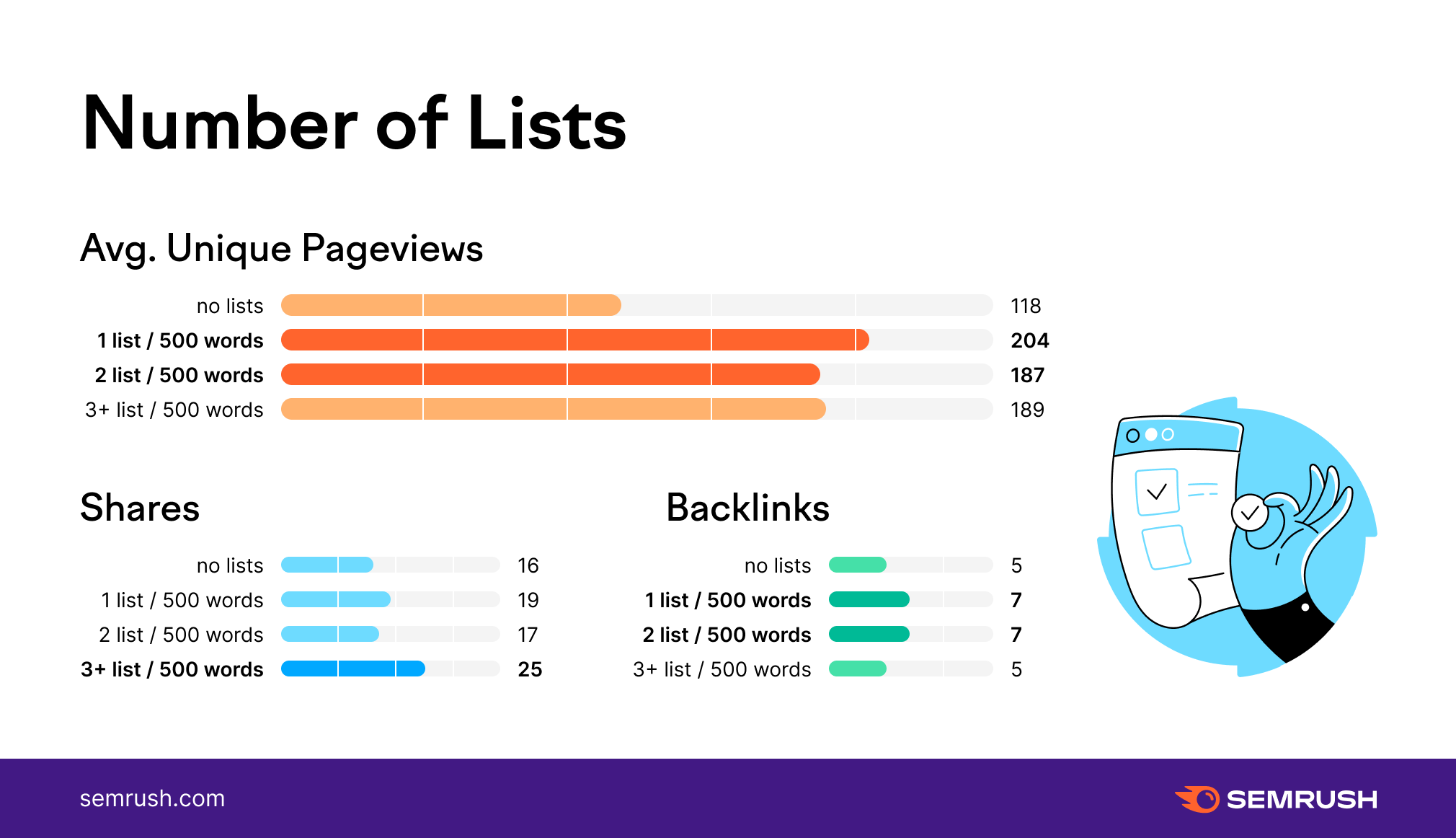
Key Takeaways: Posts containing at least one list per every 500 words of plain text get 70% more traffic than articles without lists.
As we have already mentioned, the human brain likes lists. In a famous study, renowned neuroscientist Walter Kintsch found that people process information in a list format far more easily than in bulk pieces of text and data.
Unsurprisingly, these findings also apply to your content. Lists are compatible with the short attention spans of most readers, and suggest that they can obtain the solution to their questions in a set number of steps.
Using <ul> tags can help optimize your content for search engines, too. According to the Content Marketing Institute, this approach helps search crawlers to identify list items more easily and, when applied alongside a proper heading structure, make your content eligible for Google’s featured snippet.
Visual Content
After analyzing so many textual characteristics and trends, we also decided to broaden the scope of our study to include visuals. Images and videos play a considerable role in how a reader perceives and responds to content, as we can see below.
The Use of Images
First, we looked at the use of images in the content:
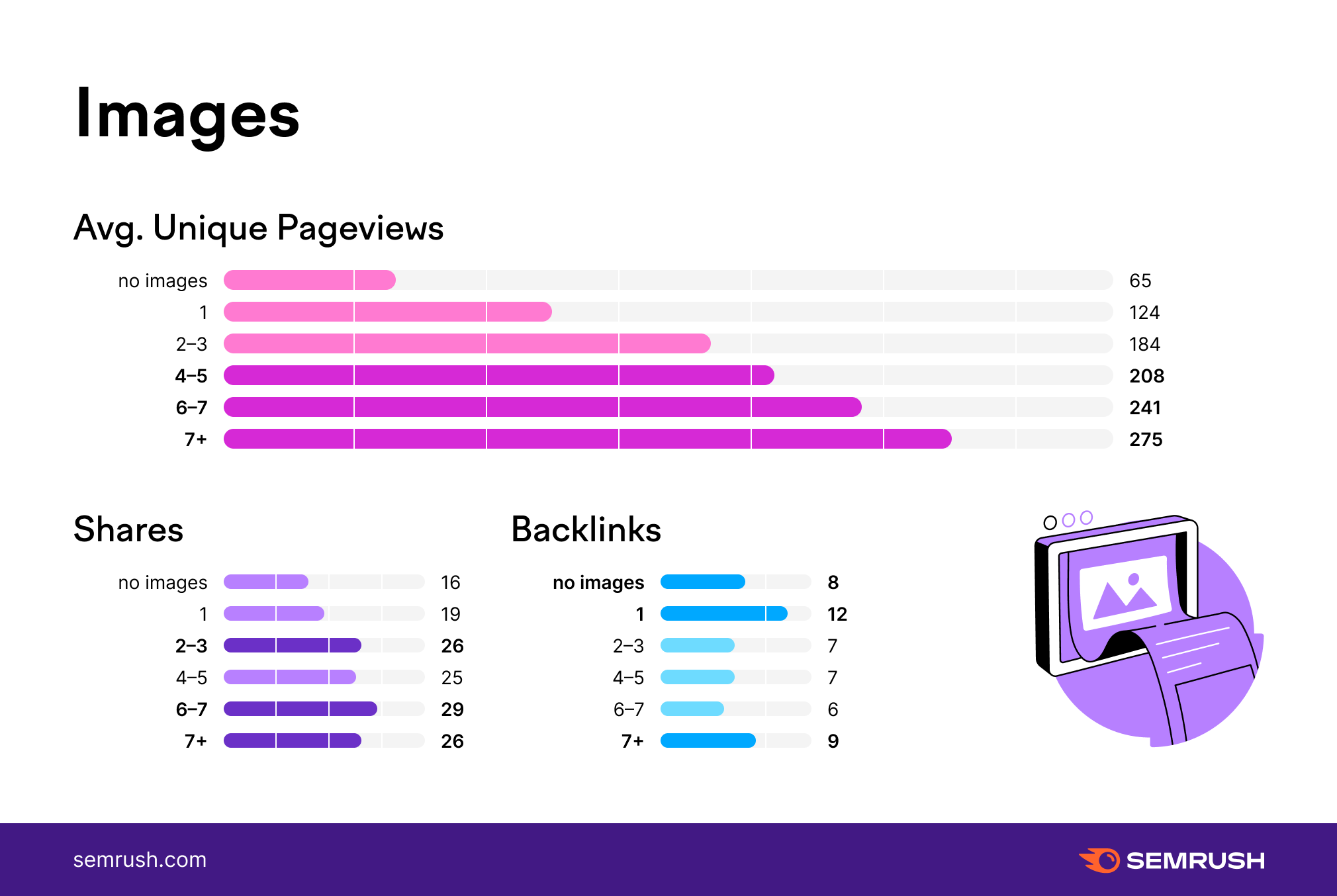
Key Takeaway: Posts with one image get twice as much traffic as posts containing text only. These also get 30% more shares and 25% more backlinks.
Although often overlooked, images are an important content element. On a basic level, humans are generally visual beings, and the use of images can — as the data above suggests — make content more attractive to readers.
Images help you to enhance and clarify your messaging, make your content more memorable, and keep short attention spans interested. Importantly, images can also be repurposed into a diverse range of media types, allowing you to tailor your graphics to different platforms and audiences.
There are also significant SEO benefits, with the potential to rank in image searches, as well as the possibility of leveraging emerging technologies such as visual search.
The Use of Videos
Images are not the only visuals we looked at; we also wanted to see if videos are worth investing in.
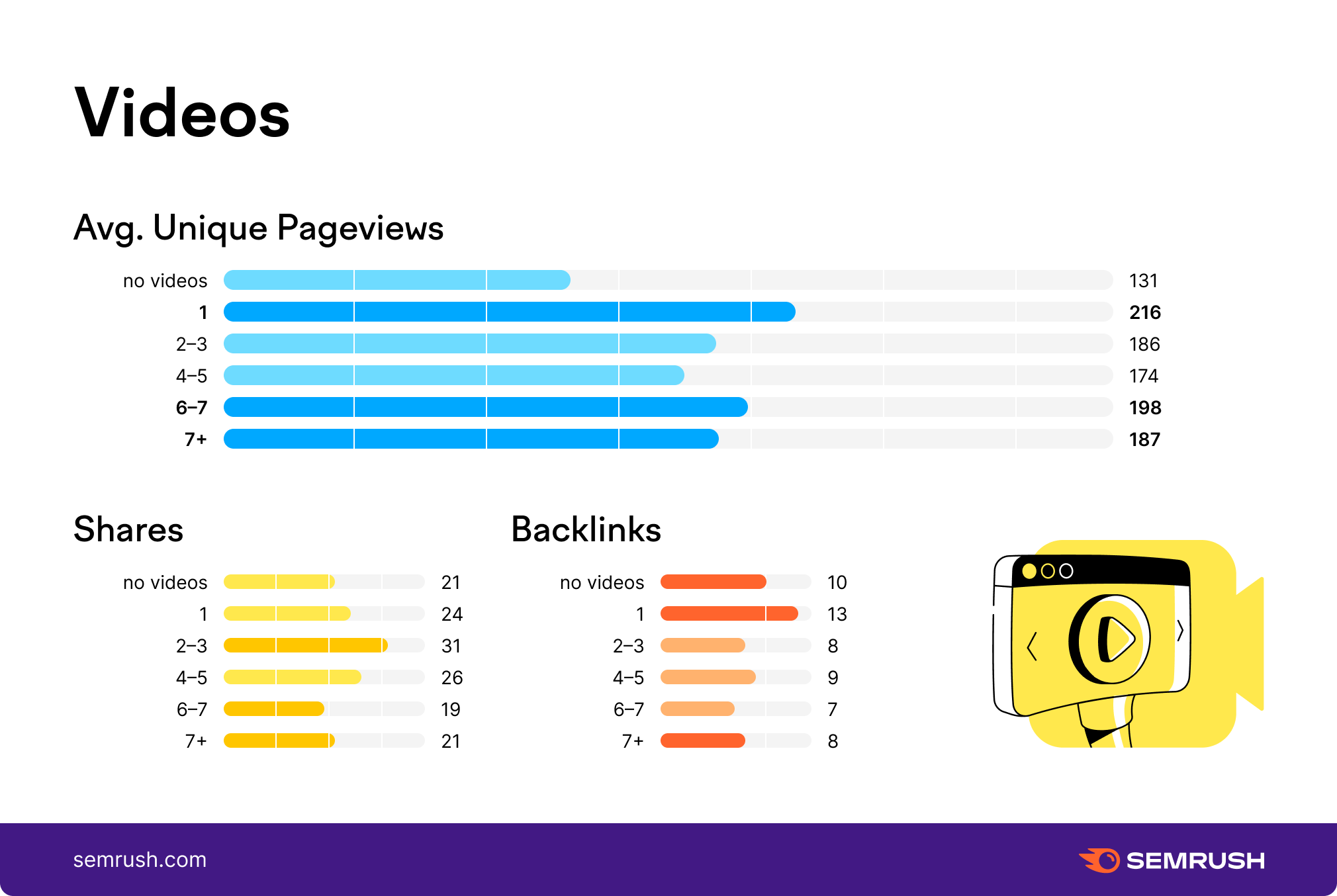
Key Takeaway: Posts that don’t contain a video get 92% less traffic and 24% less shares than posts with at least one video.
In recent years, the use of video in content has continued to grow. According to animation studio Wyzowl, 86% of businesses are using video as a marketing tool in 2021, compared to just 61% in 2016. And when you also consider Cisco’s forecast that internet traffic from videos will make up 82% of all global consumer internet traffic in 2021, it’s fair to say that video is the future of content marketing.
This is unsurprising, given that video is a hugely useful and flexible tool. Primarily, it is perfect for cross-channel distribution, allowing you to share your video across a wide range of platforms. You can also use it to address different user needs, such as ‘how-to’ videos, interviews with experts or influencers, or product demos. Indeed, video can be particularly important for converting leads, with over half of consumers using the medium to influence their purchasing decisions.
In terms of SEO, using video in your posts can increase engagement too, boosting the time spent on page considerably. If you host the videos on your own website (as opposed to YouTube or Vimeo), you can also potentially attract a lot of valuable backlinks.
Research Methodology
We picked 1,200,000 articles published on blogs that had 3 between 30,000 and 500,000 sessions. We also discarded the articles published later than June 2020.
While evaluating the performance of each article, we looked at the traffic (average unique pageviews), engagement on social media (Twitter + Facebook), and backlinks. We averaged these metrics to split all articles into high-performing (20%), average-performing (60%), and low-performing (20%) ones.
Then, we tried to establish the reference values for the most common characteristics of the content, specifically:
-
length;
-
headline types (how-tos, lists, questions, guides/studies, etc.);
-
H1 length;
-
heading depth (H2, H3, H4);
-
list presence;
-
image presence;
-
video presence.
Conclusion
The findings of our research revealed some interesting trends related to high-performing articles.
The good copy answers the reader’s query in detail, while also being well-structured and easy to navigate. It also offers a guide to action in the form of a checklist or how-to. Images and videos add value to the textual information you provide, too.
Of course, our study presents general observations and the performance of your content depends primarily on its quality, as well as its relevance for your audience. In the meantime, we are continuously working to broaden the scope of our report for next year, and hope that the information we have presented helps your content strategy going forward.
